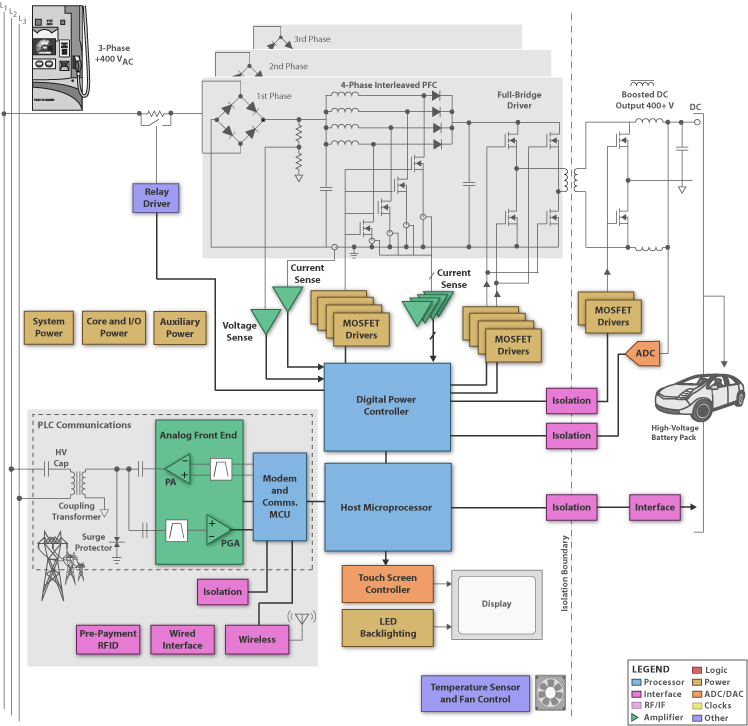
Design Considerations
Plug-in Hybrid Electric Vehicles (PHEV) and Battery Electric Vehicles (BEV) are two quickly emerging technologies which use powerful electric motors and high voltage battery packs as the propulsion and energy sources. Since batteries have a finite energy capacity, PHEV and BEV must be recharged on a periodic basis, typically by connecting to the power grid. When doing so, some form of communication (PLC, wireless, or RFID) might be used to manage the charging activity and aid in identifying and authenticating the vehicle or owner for billing purposes. Level 3 charging will play a key role in the public charging area in order to reduce the charging time and make it more feasible for the user to benefit from on-the-go charging.
The Level 3 charging system for these vehicles consists of an AC/DC converter to generate a DC voltage from the AC line. This incoming power needs to undergo power factor correction (PFC) to boost the power factor to meet regional regulatory standards. At the heart of the inverter is a real-time C2000 microcontroller. This controller is programmed to perform the control loops for all necessary power management functions, including AC/DC with PFC and DC/DC to create the necessary charge profile for the battery. The C2000 controller contains advanced peripherals such as high precision PWM outputs and ADCs, and is designed to read the ADC and adjust the PWM within a single clock cycle making real time control possible.
While the C2000 manages the power, the host controller will have the responsibility using the information provided by the communications modem and temperature sensing to drive a display and communicate directly with the on-board battery pack. The necessary information for the charge profile will be delivered to the power controller and important charging diagnostics and battery status will be sent to the display of the Level 3 charging system.
For safety reasons, isolation between the processor and the current and voltage is also required, as well as on the communications bus to the outside world. TI digital isolators have logic input and output buffers separated by TI's silicon dioxide (SiO2) isolation barrier, providing 4kV of isolation. Used in conjunction with isolated power supplies, these devices block high voltage, isolate grounds, and prevent noise currents from entering the local ground and interfering with or damaging sensitive circuitry. High-performance analog parts are also available to provide critical system functions such as MOSFET drivers, sensor feedback, chip power supplies, and communication transceivers.
Communications on a simple system can be handled by a single processor. More elaborate systems with complex displays and online billing/reporting, such as Level 3 charging, may require a secondary controller. Implementing a Low Frequency NarrowBand PLC (LF NB PLC) solution provides an optimal fit in terms of bandwidth, power, and cost requirements. Operating in the narrowband domain (frequencies up to 500 kHz) ensures data integrity while minimizing system cost. In doing so, this standard would leverage the existing power line infrastructure and provide a cost-effective means of integrating intelligent monitoring and control into new automotive systems. Data rates can vary from 1.2 kbps up to hundreds of kbps based on the existing standards. TI's PLC software is delivered in the plcSUITE library and enables developers to support several modulations and standards on one unique design. Developers can implement SFSK IEC61334, PRIME and G3 standards as well as FlexOFDM for custom OFDM implementation and is scalable for the incoming standards. For details, visit our PLC Applications Page. In addition, wireless communication and/or RFID may be needed as a secondary communication protocol and as a means of identification and billing.
Click here for additional information
Download Full Block Diagram Below
Advertisement

Learn more about Texas Instruments





